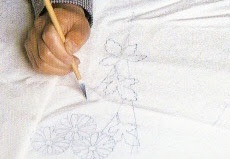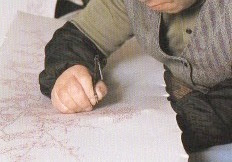Preamble
For your convenience, I have listed below other post on Japanese textiles on this blogspot.
Discharge Thundercloud
The Basic Kimono Pattern
The Kimono and Japanese Textile Designs
Traditional Japanese Arabesque Patterns - Part I
Textile Dyeing Patterns of Japan
Traditional Japanese Arabesque Patterns - Part II
Sarasa Arabesque Patterns
Contemporary Japanese Textile Creations
Shibori (Tie-Dying)
History of the Kimono
A Textile Tour of Japan - Part I
A Textile Tour of Japan - Part II
The History of the Obi
Japanese Embroidery (Shishu)
Japanese Dyed Textiles
Aizome (Japanese Indigo Dyeing)
Stencil-Dyed Indigo Arabesque Patterns
Japanese Paintings on Silk
Tsutsugaki - Freehand Paste-Resist Dyeing
Street Play in Tokyo
Birds and Flowers in Japanese Textile Designs
Japanese Colors and Inks on Paper From the Idemitsu Collection
Yuzen: Multicolored Past-Resist Dyeing - Part I
Yuzen: Multi-colored Paste-Resist Dyeing - Part II
Katazome (Stencil Dyeing) - Part I
Katazome (Stencil Dyeing) - Part II
Katazome (Stencil Dyeing) - Part III
Yuzen: Multi-Colored Past-Resist Dyeing - Part 1 [1]
The Edo period (between 1603 and 1867) was a time of great creativity. Throughout Japan, local governments developed and encouraged the products of regional industry. The capital city of Edo was a hotbed of new ideas This period was characterized by a flamboyance in dress. Not only were members of the elite Samurai class often in debt due to excessive clothing expenses but the merchants, who gained control of the economy in this period, also began to dress extravagantly. In defiance of the shogunate's sumptuary laws, the common people clamoured for new textiles.
A new dyeing technique called yuzen was developed around 1700 in response to this demand. The new art form, developed by and named after a fan painter named MIyazaki Yuzensai, was distinguished by its beautiful colors and pictorial designs.
This yuzen kosode depicts a falcon perched on a folding screen. Embroidery is effectively used for details such as the falcon's jesses.
Note: A jess (plural "jesses") is a thin strap, traditionally made from leather, used to tether a hawk or falcon in falconry. Jesses allow a falconer to keep control of a bird while it is on the glove or in training, and allow a bird to be secured on a perch outside its aviary.
Over the years yuzen developed into a major textile art. Yuzen was originally produced in the the city of Kyoto, where the waters of the Kamo River were ideal for rinsing the bolts of fabric after the dyeing process, and in Kaga Province. From about 1665, with Lord Maeda's patronage, Kaga became a center of art, industry and learning, on par with Kyoto. Lord Maeda's love of fine fabrics and the arts was well known, and with his encouragement of weaving and dyeing, Kaga silk and Kaga yuzen became famous. Later yuzen was also made in Edo and was known as Edo yuzen.
Yuzen is divided into two basic types, free hand paste drawing (tegaki) yuzen and stencil (kata) yuzen, according to the method of paste application used. Freehand yuzen starts with small version of the design on paper. It is enlarged to its final size as it is drawn onto the kimono silk with a fugitive blue aobana liquid (an extract of the spiderwort plant).
In the yuzen process designs are first drawn with the aobana liquid.
During most of the steps in the yuzen process, the silk is stretched on pliable bamboo rods called shinshi to allow the craftsman to draw and brush-dye the fabric.
With the shinshi in place, rice-paste resist (mochiko) of a finer consistency is drawn on the fabric along the blue aobana lines using a waterproof paper tube with a small metal tip.
The aobana lines are next covered with a paste resist.
Then a thin liquid soybean extract (gojiru) is spread over the paste and fabric. When dry, the paste works as a resist, keeping the dye inside its borders, while the soybean extract further reduces the chance of unwanted running and aids in the absorption of the dye into the silk. For even spreading of the dyes, water is brushed over the area to be colored and the dye is then applied with a small felt brush.
After applying the paste resist, dye is painted on with a brush.
After steaming the silk to set the dye, the paste is washed out, leaving delicate white lines that outline the colorful motifs and pictures of the design.
To protect the completed design during later dyeing, an additional coat of paste is applied over this area and the background dye is brushed on.
Various colors of dye - infused paste used in stencil yuzen.
After a final steaming, the paste is wah out again and the fabric is stretched on shinshi to dry. This delicately decorated silk is ready to be hand-stitched into a kimono which will be protected in a paper wrapper (tatoshi) until worn.
Section of a Kyo yuzen furisode in stunning colors, with tie-dye (Kyo fawn spots) and couched gold thread.
A Kyo yuzen kimono with a banquet scene at a palace depicted in bright hues. The garden in full bloom is surrounded by decorative curtains.
Pretty flower motifs of a yuzen stencil.
Reference:
[1] A. Yang and R. M. Narasin, Shufunotomo. Co., Ltd.,Tokyo (1989).
For your convenience, I have listed below other post on Japanese textiles on this blogspot.
Discharge Thundercloud
The Basic Kimono Pattern
The Kimono and Japanese Textile Designs
Traditional Japanese Arabesque Patterns - Part I
Textile Dyeing Patterns of Japan
Traditional Japanese Arabesque Patterns - Part II
Sarasa Arabesque Patterns
Contemporary Japanese Textile Creations
Shibori (Tie-Dying)
History of the Kimono
A Textile Tour of Japan - Part I
A Textile Tour of Japan - Part II
The History of the Obi
Japanese Embroidery (Shishu)
Japanese Dyed Textiles
Aizome (Japanese Indigo Dyeing)
Stencil-Dyed Indigo Arabesque Patterns
Japanese Paintings on Silk
Tsutsugaki - Freehand Paste-Resist Dyeing
Street Play in Tokyo
Birds and Flowers in Japanese Textile Designs
Japanese Colors and Inks on Paper From the Idemitsu Collection
Yuzen: Multicolored Past-Resist Dyeing - Part I
Yuzen: Multi-colored Paste-Resist Dyeing - Part II
Katazome (Stencil Dyeing) - Part I
Katazome (Stencil Dyeing) - Part II
Katazome (Stencil Dyeing) - Part III
Yuzen: Multi-Colored Past-Resist Dyeing - Part 1 [1]
The Edo period (between 1603 and 1867) was a time of great creativity. Throughout Japan, local governments developed and encouraged the products of regional industry. The capital city of Edo was a hotbed of new ideas This period was characterized by a flamboyance in dress. Not only were members of the elite Samurai class often in debt due to excessive clothing expenses but the merchants, who gained control of the economy in this period, also began to dress extravagantly. In defiance of the shogunate's sumptuary laws, the common people clamoured for new textiles.
A new dyeing technique called yuzen was developed around 1700 in response to this demand. The new art form, developed by and named after a fan painter named MIyazaki Yuzensai, was distinguished by its beautiful colors and pictorial designs.
This yuzen kosode depicts a falcon perched on a folding screen. Embroidery is effectively used for details such as the falcon's jesses.
Note: A jess (plural "jesses") is a thin strap, traditionally made from leather, used to tether a hawk or falcon in falconry. Jesses allow a falconer to keep control of a bird while it is on the glove or in training, and allow a bird to be secured on a perch outside its aviary.
Over the years yuzen developed into a major textile art. Yuzen was originally produced in the the city of Kyoto, where the waters of the Kamo River were ideal for rinsing the bolts of fabric after the dyeing process, and in Kaga Province. From about 1665, with Lord Maeda's patronage, Kaga became a center of art, industry and learning, on par with Kyoto. Lord Maeda's love of fine fabrics and the arts was well known, and with his encouragement of weaving and dyeing, Kaga silk and Kaga yuzen became famous. Later yuzen was also made in Edo and was known as Edo yuzen.
Yuzen is divided into two basic types, free hand paste drawing (tegaki) yuzen and stencil (kata) yuzen, according to the method of paste application used. Freehand yuzen starts with small version of the design on paper. It is enlarged to its final size as it is drawn onto the kimono silk with a fugitive blue aobana liquid (an extract of the spiderwort plant).
In the yuzen process designs are first drawn with the aobana liquid.
During most of the steps in the yuzen process, the silk is stretched on pliable bamboo rods called shinshi to allow the craftsman to draw and brush-dye the fabric.
With the shinshi in place, rice-paste resist (mochiko) of a finer consistency is drawn on the fabric along the blue aobana lines using a waterproof paper tube with a small metal tip.
The aobana lines are next covered with a paste resist.
Then a thin liquid soybean extract (gojiru) is spread over the paste and fabric. When dry, the paste works as a resist, keeping the dye inside its borders, while the soybean extract further reduces the chance of unwanted running and aids in the absorption of the dye into the silk. For even spreading of the dyes, water is brushed over the area to be colored and the dye is then applied with a small felt brush.
After applying the paste resist, dye is painted on with a brush.
After steaming the silk to set the dye, the paste is washed out, leaving delicate white lines that outline the colorful motifs and pictures of the design.
To protect the completed design during later dyeing, an additional coat of paste is applied over this area and the background dye is brushed on.
Various colors of dye - infused paste used in stencil yuzen.
After a final steaming, the paste is wah out again and the fabric is stretched on shinshi to dry. This delicately decorated silk is ready to be hand-stitched into a kimono which will be protected in a paper wrapper (tatoshi) until worn.
Section of a Kyo yuzen furisode in stunning colors, with tie-dye (Kyo fawn spots) and couched gold thread.
A Kyo yuzen kimono with a banquet scene at a palace depicted in bright hues. The garden in full bloom is surrounded by decorative curtains.
Pretty flower motifs of a yuzen stencil.
Reference:
[1] A. Yang and R. M. Narasin, Shufunotomo. Co., Ltd.,Tokyo (1989).









No comments:
Post a Comment